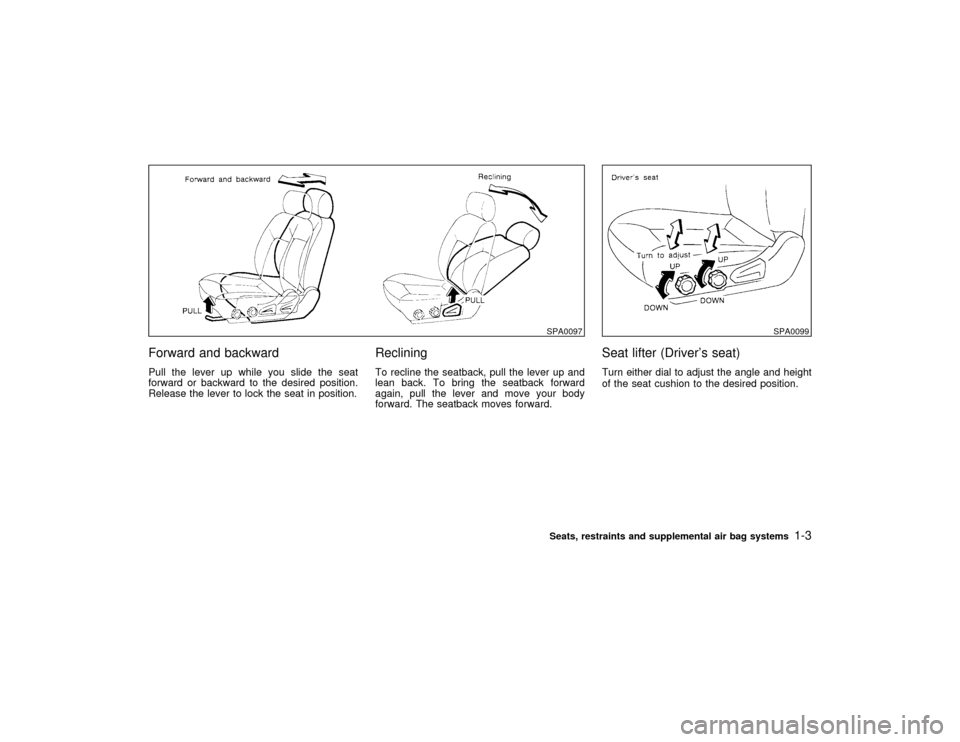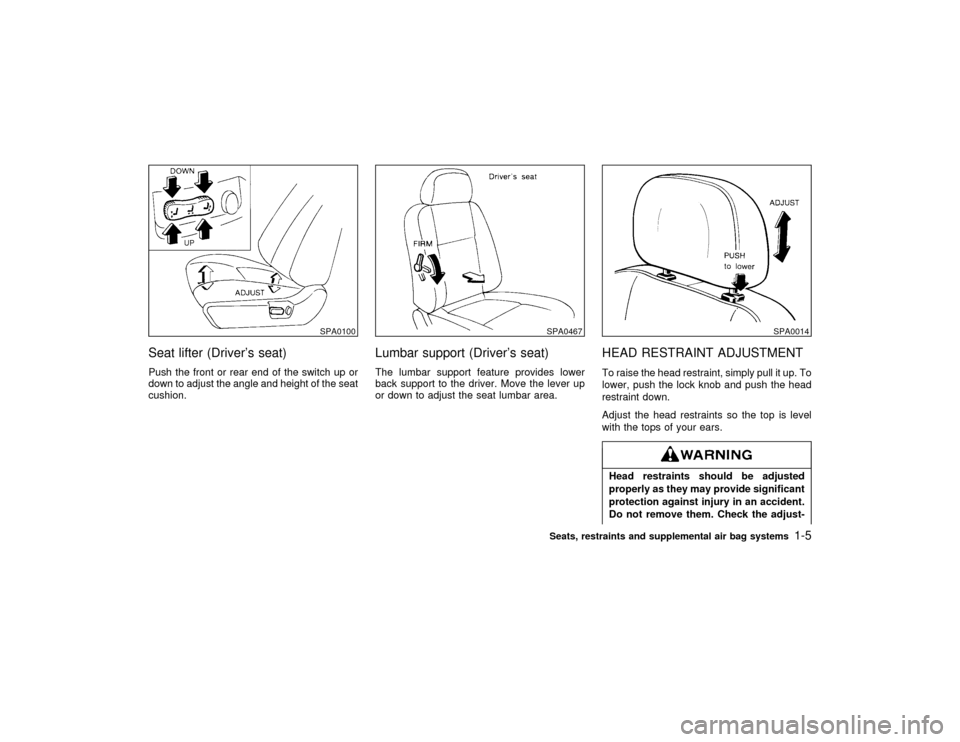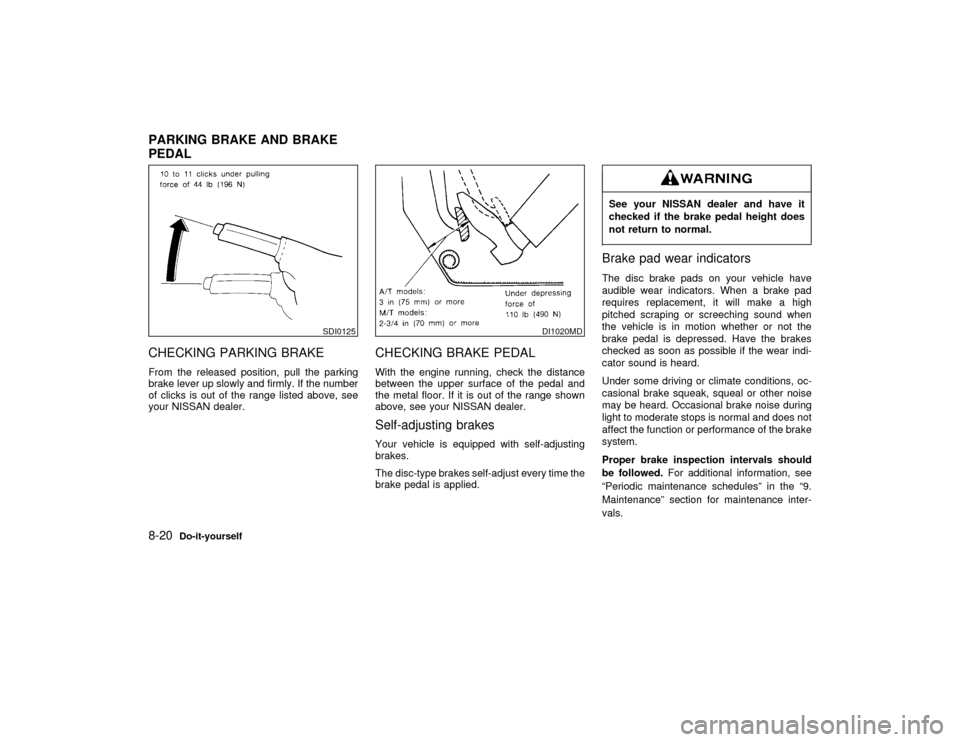1998 NISSAN MAXIMA height
[x] Cancel search: heightPage 10 of 231

Forward and backwardPull the lever up while you slide the seat
forward or backward to the desired position.
Release the lever to lock the seat in position.
RecliningTo recline the seatback, pull the lever up and
lean back. To bring the seatback forward
again, pull the lever and move your body
forward. The seatback moves forward.
Seat lifter (Driver's seat)Turn either dial to adjust the angle and height
of the seat cushion to the desired position.
SPA0097
SPA0099
Seats, restraints and supplemental air bag systems
1-3
Z
01.1.31/A32-D
X
Page 12 of 231

Seat lifter (Driver's seat)Push the front or rear end of the switch up or
down to adjust the angle and height of the seat
cushion.
Lumbar support (Driver's seat)The lumbar support feature provides lower
back support to the driver. Move the lever up
or down to adjust the seat lumbar area.
HEAD RESTRAINT ADJUSTMENTTo raise the head restraint, simply pull it up. To
lower, push the lock knob and push the head
restraint down.
Adjust the head restraints so the top is level
with the tops of your ears.Head restraints should be adjusted
properly as they may provide significant
protection against injury in an accident.
Do not remove them. Check the adjust-
SPA0100
SPA0467
SPA0014
Seats, restraints and supplemental air bag systems
1-5
Z
01.1.31/A32-D
X
Page 29 of 231

forward. The retractor should lock and re-
strict further belt movement.
If the retractor does not lock during this check
or if you have any questions about belt opera-
tion, see your NISSAN dealer.
Shoulder belt height adjustment
(For front seats)The shoulder belt anchor height should be
adjusted to the position best for you. (See
ªPrecautions on seat belt usageº earlier in this
section.) To adjust, squeeze the release but-
tons, and then move the shoulder belt anchor
to the desired position, so that the belt passes
over the center of the shoulder. The belt
should be away from your face and neck, but
not falling off of your shoulder. Release the
adjustment buttons to lock the shoulder belt
anchor into position.
IAfter adjustment, release the buttons
and try to move the shoulder belt
anchor up and down to make sure it
is securely fixed in position.
IThe shoulder belt anchor height
should be adjusted to the position
best for you. Failure to do so may
reduce the effectiveness of the entire
restraint system and increase the
chance or severity of injury in an
accident.
PD1321-A
1-22
Seats, restraints and supplemental air bag systems
Z
01.1.31/A32-D
X
Page 175 of 231

CHECKING PARKING BRAKEFrom the released position, pull the parking
brake lever up slowly and firmly. If the number
of clicks is out of the range listed above, see
your NISSAN dealer.
CHECKING BRAKE PEDALWith the engine running, check the distance
between the upper surface of the pedal and
the metal floor. If it is out of the range shown
above, see your NISSAN dealer.Self-adjusting brakesYour vehicle is equipped with self-adjusting
brakes.
The disc-type brakes self-adjust every time the
brake pedal is applied.
See your NISSAN dealer and have it
checked if the brake pedal height does
not return to normal.Brake pad wear indicatorsThe disc brake pads on your vehicle have
audible wear indicators. When a brake pad
requires replacement, it will make a high
pitched scraping or screeching sound when
the vehicle is in motion whether or not the
brake pedal is depressed. Have the brakes
checked as soon as possible if the wear indi-
cator sound is heard.
Under some driving or climate conditions, oc-
casional brake squeak, squeal or other noise
may be heard. Occasional brake noise during
light to moderate stops is normal and does not
affect the function or performance of the brake
system.
Proper brake inspection intervals should
be followed.For additional information, see
ªPeriodic maintenance schedulesº in the ª9.
Maintenanceº section for maintenance inter-
vals.
SDI0125
DI1020MD
PARKING BRAKE AND BRAKE
PEDAL8-20
Do-it-yourself
Z
01.1.31/A32-D
X
Page 176 of 231

BRAKE BOOSTERCheck the brake booster function as follows:
1. With the engine off, press and release the
brake pedal several times. When brake
pedal movement (distance of travel) re-
mains the same from one pedal application
to the next, continue on to the next step.
2. While depressing the brake pedal, start the
engine. The pedal height should drop a
little.
3. With the brake pedal depressed, stop the
engine. Keeping the pedal depressed for
about 30 seconds, the pedal height should
not change.
4. Run the engine for one minute without
depressing the brake pedal, then turn it off.
Depress the brake pedal several times. The
pedal travel distance will decrease gradu-
ally with each depression as the vacuum is
released from the booster.
If the brakes do not operate properly, see your
NISSAN dealer.Press the pedal by hand and be sure the free
travel is within the limits shown above. If free
travel is too little or too much, see your
NISSAN dealer.
Never use a fuse of higher amperage
rating than that specified on the fuse
box cover. This could damage the elec-
trical system or cause a fire.
DI1021MC
CLUTCH PEDAL FUSES
Do-it-yourself
8-21
Z
01.1.31/A32-D
X
Page 189 of 231

IAfter rotating the tires, adjust the tire
pressure.
IRetighten the wheel nuts after the
aluminum wheels have been run for
the first 600 miles (1,000 km) (also in
cases of a flat tire, etc.).
IDo not include the T-type spare tire or
any other small size spare tire in the
tire rotation.
Tire wear and damageTires should be periodically inspected
for wear, cracking, bulging, or objects
caught in the tread. If excessive wear,
cracks, bulging, or deep cuts are found,
the tire should be replaced.
The original tires have a built-in tread
wear indicator. When the wear indicator
is visible, the tire should be replaced.
Improper service for a T-type spare tiremay result in serious personal injury. If
it is necessary to repair the T-type spare
tire, contact your NISSAN dealer.
Replacing tires and wheelsWhen replacing a tire, use the same size,
speed rating and load carrying capacity as
originally equipped. See ªSpecificationsº in the
ª10. Technical and consumer informationº sec-
tion for recommended types and sizes of tires
and wheels.IThe use of tires other than those
recommended or the mixed use of
tires of different brands, construction
(bias, bias-belted or radial), or tread
patterns can adversely affect the ride,
braking, handling, ground clearance,
body-to-tire clearance, tire chain
clearance, speedometer calibration,
headlight aim and bumper height.
Some of these effects may lead to
accidents and could result in serious
personal injury.
IIf the wheels are changed for any
reason, always replace with wheels
MDI0004
8-34
Do-it-yourself
Z
01.1.31/A32-D
X
Page 211 of 231

TIRES AND WHEELSRoad wheelSteel 15 x 6JJ
Offset in (mm) 1.57 (40)
Aluminum15 x 6.5JJ
16 x 6.5JJ
Offset in (mm) 1.77 (45)
Tire sizeConventionalP205/65R15 92S
P205/65R15 92H
P215/55R16 91H
SpareConventional*1
T125/70D16*2
T125/90D16*2, *3
*1: For CANADA
*2: For US
*3: For models with Viscous LSD
DIMENSIONS AND WEIGHTS
Sedan
Overall length in (mm) 189.4 (4,810)
Overall width in (mm) 69.7 (1,770)
Overall height in (mm) 55.7 (1,415)
Front tread in (mm)60.2 (1,530)*1
59.8 (1,520)*2
Rear tread in (mm)59.4 (1,510)*1
59.1 (1,500)*2
Wheelbase in (mm) 106.3 (2,700)
Gross vehicle weight rating lb (kg)
See the F.M.V.S.S. certifica-
tion label on the driver's side
lock pillar. Gross axle weight rating
Front lb (kg)
Rear lb (kg)
*1: For models with steel wheels
*2: For models with aluminum wheels
10-8
Technical and consumer information
Z
01.1.31/A32-D
X
Page 224 of 231

11 Index
A
ABS ................................................................. 5-18
Adjusting the time ........................................... 2-25
Adjustment
Front manual seat ....................................... 1-2
Front power seat ......................................... 1-4
Head restraint .............................................. 1-5
Shoulder belt ............................................. 1-22
Air bag
System....................................................... 1-12
System, Side ............................................. 1-13
Warning label ............................................ 1-15
Warning light ...................................... 1-15, 2-8
Air cleaner....................................................... 8-18
Air conditioner
Automatic..................................................... 4-9
Manual ......................................................... 4-3
Operation, Manual ....................................... 4-5
Servicing .................................................... 4-12
Specification label ................................... 10-11
Air conditioning system refrigerant and
lubricant recommendations ............................. 10-6
Aluminum alloy wheels, Cleaning ..................... 7-4
Anchor point location, Top strap..................... 1-35
Antenna........................................................... 4-25
Anti-freeze, Cold weather ............................... 5-19
Anti-lock Brake System (ABS) ........................ 5-18Appearance care
Exterior ........................................................ 7-2
Interior ......................................................... 7-4
Armrest ............................................................. 1-6
Ashtray ............................................................ 2-19
Audio system .................................................. 4-12
Automatic
Operation, Air conditioner ......................... 4-10
Sunroof, Operation .................................... 2-24
Transaxle fluid ........................................... 8-10
Transmission, Driving .................................. 5-7
Avoiding collision and rollover .......................... 5-3
B
Battery
Cold weather ............................................. 5-19
Maintenance .............................................. 8-14
Replacement, Multi-remote control ............. 3-7
Before starting the engine ................................ 5-6
Belt
Drive .......................................................... 8-15
Extender, Seat........................................... 1-25
Height adjustment, Shoulder ..................... 1-22
Maintenance, Seat .................................... 1-25
Seat ........................................................... 1-17
Brake
Booster ...................................................... 8-21
Fluid ........................................................... 8-12Parking ...................................................... 5-12
Pedal ......................................................... 8-20
System....................................................... 5-17
Warning light ............................................... 2-8
Break-in schedule ........................................... 5-14
Bulb
Checking...................................................... 2-7
Indicator ....................................................... 2-9
Replacement ............................................. 8-25
Warning light ............................................... 2-7
Buzzer ............................................................. 2-11
C
Capacities and recommended fuel/lubricant .. 10-2
Car phone ....................................................... 4-25
Carbon monoxide, Exhaust gas ....................... 5-2
Cassette tape player operation....................... 4-15
Cassette tape player operation, with compact disc
(CD) player type ............................................. 4-21
Catalytic converter, Three way catalyst............ 5-2
CB radio or car phone .................................... 4-25
Ceiling light ..................................................... 2-25
Certification label, F.M.V.S.S. ....................... 10-10
Chain, Tire ...................................................... 8-33
Changing
A flat tire ...................................................... 6-2
Engine coolant............................................. 8-6
Engine oil..................................................... 8-9
Engine oil filter........................................... 8-10
Z
01.1.31/A32-D
X